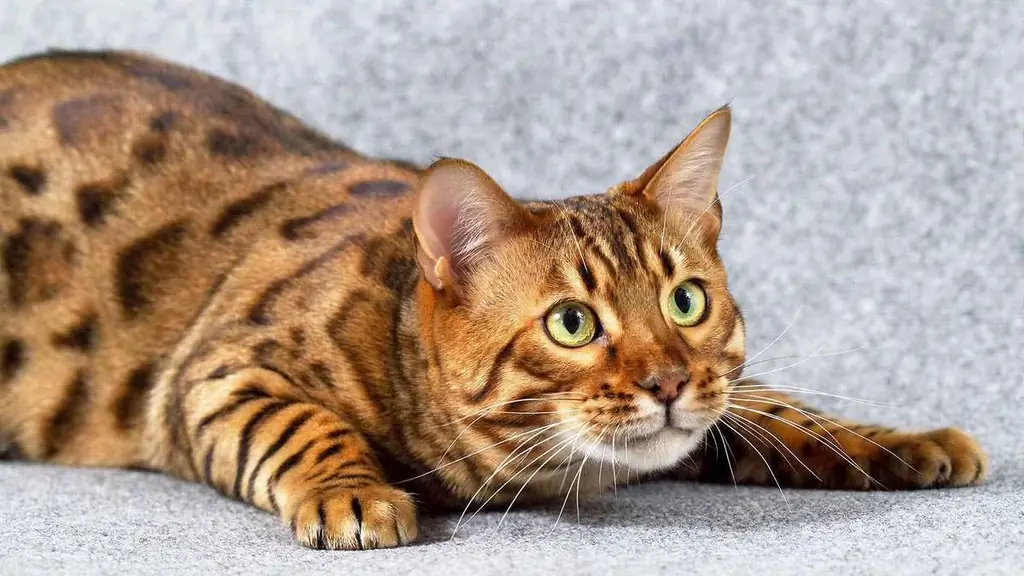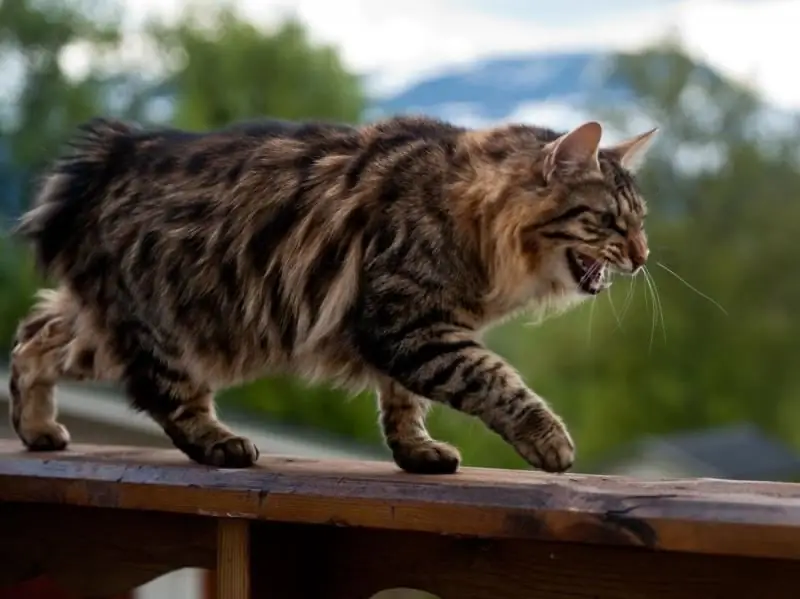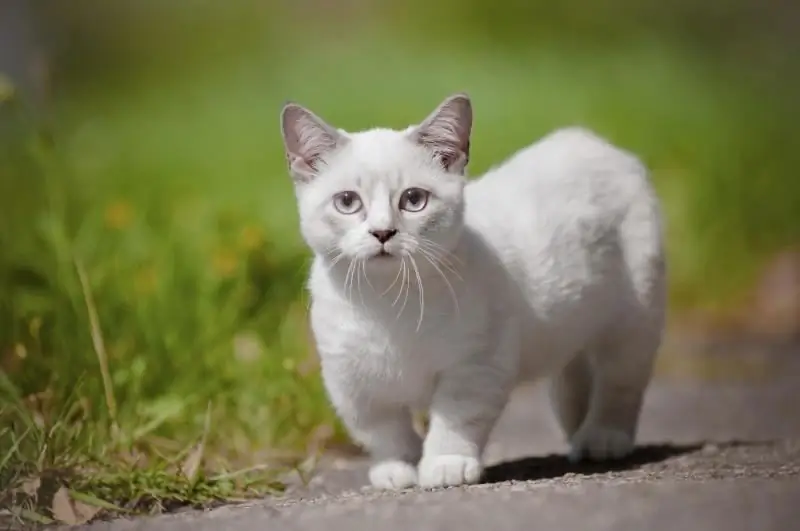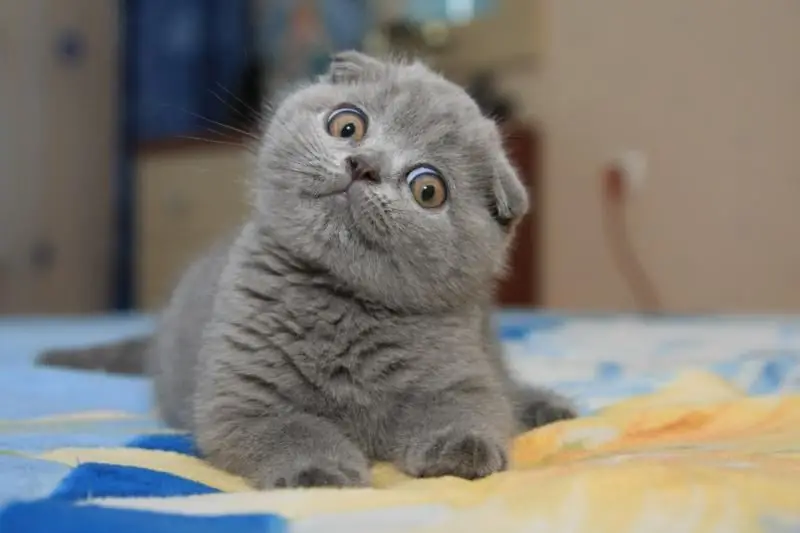
Table of contents:
- Author Bailey Albertson [email protected].
- Public 2024-01-17 22:26.
- Last modified 2025-06-01 07:32.
Ragdoll: all about the breed

Starting a cat, every owner dreams of having an agreeable, sociable pet with a lively character and the spontaneity inherent in this type of animal. In practice, it turns out that not all breeds meet the above characteristics. However, by choosing a ragdoll, the future owner receives not only this, but also something more - the sincere affection of the cat.
Content
- 1 History of the origin of the breed
-
2 External features of the Ragdoll breed
- 2.1 Table: Ragdoll Breed Standards
-
2.2 Color
- 2.2.1 Mitted
- 2.2.2 Photo gallery: mitted ragdolls
- 2.2.3 Bicolor
- 2.2.4 Photo gallery: bicolor ragdolls
- 2.2.5 Color point
- 2.2.6 Photo gallery: color-point ragdolls
- 3 Character and behavior of the breed
- 4 What diseases do ragdolls suffer from most often?
-
5 How to care for the breed
- 5.1 Hygiene
- 5.2 Toilet
- 5.3 Feeding
- 5.4 Castration and sterilization
- 6 How to choose a ragdoll kitten
History of the origin of the breed
The Ragdoll breed was bred in the state of California by breeder Ann Baker. The woman owned an angora cat named Josephine, whose docile nature was entrenched in all representatives of the ragdolls.

Anne Baker was the first to demonstrate the ability of ragdolls to completely relax in the hands of a person
So, the progenitor of the breed was crossed with a Burmese cat and, as a result, they got offspring with interesting properties - the kittens had a reduced muscle tone. Ann Baker drew attention to this feature and started breeding only the most relaxed and obedient animals. As a result, in 1965 a new breed of cats was registered under the name Ragdoll, which means "rag doll" in English.
Breeding and, accordingly, the distribution of the breed can only be engaged in catteries that have membership in organizations such as TICA (International Cat Association). Clubs from Canada, Czech Republic, Greece, France, New Zealand, England and, of course, America are represented on its official website. Representatives of the Ragdoll breed are exported outside these countries solely for keeping, not breeding. For these purposes, the breeders send the main documents of the animal only after the owners present a certificate of sterilization. However, despite these nuances, the ragdoll cat is a member of families from many different countries.
External features of the Ragdoll breed
The main characteristics of the ragdoll:
- silk wool of medium length, similar in quality to rabbit fur;
- the weight of adult cats is about 6 kg, and that of cats is 9 kg;
- large mustache white;
- lack of black, red and gray color;
-
eyes are bright blue.

Ragdoll face The angelic look of ragdoll's clean eyes is not at all a decoy, they are really very peaceful and kind cats
There are breed standards established by TICA (the world's largest felinological organization).
Table: Ragdoll breed standards
| Head | The shape of the head is a wide modified wedge with slightly rounded contours, a slightly rounded forehead (not domed) with a flatness in the area between the ears. |
| Ears | Medium in size, with a wide base and rounded tip, sloping slightly forward. |
| Eyes | Blue, large, oval, moderately broad. |
| Muzzle | Rounded, medium length. |
| Profile | A straight nose to the bridge of the nose, followed by a change in direction towards a soft curve on the forehead. |
| Neck | In proportion to the head and body. |
| Torso | Medium long. A fat pad on the lower abdomen is allowed. Females may be smaller than males. |
| Paws | Proportional to the body. The hind legs are slightly longer than the front legs. The paw pads are large, round, with tufts of hair between the toes. |
| Tail | Thicker at the base, with a slight taper. Equal to body length. |
| Musculature | Strong. |
| Wool | Medium length, with seasonal variations in density, silky soft, plush. Minimal undercoat. |
| Coat color | The main shade is light with a small amount of sharply contrasting dark. Undeveloped color is allowed in young cats. |

Ragdolls allow tufts of hair between the toes
Color
There are several colors of ragdoll cats.
Mitted
Ragdolls of mitted color can be distinguished by the mask on the muzzle. The dark spot covers almost the entire space, leaving only the chin unoccupied. And also their front legs are always dressed in white gloves, and the hind legs are completely white.
Photo gallery: mitted ragdolls
-

Ragdoll cat - In mitted cats, the hind legs are completely white.
-

Ragdoll chest coloration mitted - In mitted cats, the lower part of the neck may turn into a white stripe that runs between the front legs through the belly to the base of the tail
-

Ragdoll mitted -
The mitted color is characterized by white "socks" on the paws
Bicolor
The bicolor color is easiest to distinguish from the rest by a small bright area in the form of a symmetrical triangle in the shape of an inverted V.
Photo gallery: bicolor ragdolls
-

Young ragdoll cat - Bicolor cats have pink nose and paw pads
-

Bicolor ragdoll face - In bicolor ragdolls on the muzzle, the dark coat is interrupted by a patch of white in the shape of an inverted "V"
-

Ragdoll bicolor - The chest, belly and all 4 legs of bicolor cats must be white
Color point
Color-point differs from other colors in that the mask extends to the forehead, however, it should not extend further than the middle of the ears, at the base of the ears there is a small light area. The chest, neck and chin should be much lighter than the markings.
Photo gallery: color-point ragdolls
-

Junior ragdoll color-point - In color-point cats, the dark spot on the muzzle extends down to the forehead, but should not go beyond the ears
-

Ragdoll color-point - Color-point cats have no white spots
-

The most common color point for ragdolls - The color point should have a small, light colored patch of hair at the base of the ears
The nature and behavior of the breed
Ragdolls, unlike other breeds, are not attached to their habitat, but to the owner. This is both their positive feature and disadvantage. The pet will be happy to meet the owner after work and will be very bored if he is not at home for a long time.
An amazing ability for cats, which are freedom-loving animals by default. Having learned about this ragdoll character trait, I definitely wanted to buy it myself. Such a companion can be taken everywhere with you, and he will calmly endure the move, which is especially important for those who live in rented apartments, which include me.
The cat will fulfill all the master's ideas: whether it be moving or walking on a harness, trying on new bows and collars, or having another pet.
However, the limpness characteristic of ragdolls has a downside - they are extremely poorly tolerant of falls from great heights. That is, if the owner, holding the cat in his arms, throws it down, then the animal is guaranteed to be injured. Ragdolls in these cases must be seated on the floor, because while they are on their hands, their muscles are completely relaxed.

Ragdoll must be gently released from hands to the floor.
Ragdolls have an extremely quiet voice and they use it very delicately, so when buying a cat of this breed, you can safely forget about the screams typical of most animals of this type at 5 am and other loud "delights".
But at the same time, ragdolls are playful and you shouldn't assume that the cat will be lazy on the couch all day. Representatives of this breed are as active as any other cats.
What diseases do ragdolls most often suffer from?
The average lifespan of ragdolls is 11-15 years, but there are also centenarians, whose age can reach 16-19 years. They do not suffer from special diseases, despite the peculiarity of their bodies. Breeders distinguish only hypertrophic cardiomyopathy (characterized by thickening of the wall of the predominantly left ventricle and interventricular septum, which leads to disruption of the normal functioning of the heart muscle) and dysplasia of the hip joints (mismatch of the articular head and cavity).
How to care for a breed
There is no specificity for caring for ragdolls, except for the need to take care of yourself so as not to throw the cat on the floor with the usual gesture. In this case, due to its peculiarity associated with relaxed muscle tone, cats will certainly get injured.

Ragdoll does not require any special conditions of solicitation
Otherwise, the conditions for keeping the ragdoll are standard, you only need to purchase:
- a bowl;
- restroom;
- scratching post;
- toys;
- carrying;
- stove bench (if necessary).
At some point, dark footprints began to appear at the corners of my cat's mouth. I took her to the vet and found out that a similar ailment could be related to feeding from a plastic bowl. And indeed, after the replacement with ceramic bruises were gone. It will be useful, based on your own experience, to recommend choosing closed beds for kittens or making something similar with your own hands, because in the early days, the pet will in any case look for some kind of shelter, and let it be a place you know better than a narrow gap under sofa.
Hygiene
Despite the long coat, ragdolls do not require any special care. Cats manage their hygiene on their own. However, periodic examination of the eyes, ears, paws and brushing the coat 1-2 times a week will not hurt.
It is necessary to wash the animal only in the presence of strong pollution, for example, after traveling to nature, or to give a special gloss before the exhibition. At the same time, it is forbidden to use shampoos for people, even for children, due to the different pH and characteristics of the water-lipid layer in cats. When washing, make sure that no water gets into your pet's ears, and after the procedure, blot the cat's body well with a terry towel. Then she will dry herself, but if the animal allows, you can help her with a hair dryer at medium power and maximum distance so as not to dry out the skin.
If there are leaks from the eyes, wipe them with a cotton pad dipped in water. The tea leaves cannot be used. Do not leave dark accumulations in the corners of the cat's eyes for a long time, because due to the presence of iron in the composition of the tear fluid, they can stain the coat.
Do not use a Q-tip to clean dark ear clusters. This is due to the specific structure of the auricle in cats, due to which the owner can only reach half of it, as well as irritation of special glands responsible for secretion in the ear, which will cause a reverse reaction. For rinsing, you need to use ear lotion, and then blot with a cotton pad or let the cat wipe it off on its own.
If your cat is unable to cope with sharpening the claws, then trim them as they grow. For this, special forceps are used. It's easy to do, but it takes some skill. The difficulty lies in fixing the cat, because not everyone goes for it voluntarily. You need to cut off the curling part of the nail, a couple of millimeters from the pulp (pink part of the nail).

The main thing when cutting nails is not to touch the pulp.
Restroom
For kittens, you need to use a toilet with low sides, since getting into it will cause them significant difficulties. Choose a large pot for an adult cat, taking into account the size and weight of the animal.
Feeding
Due to their large weight, it is necessary to give daily 100-120 g of food to a ragdoll kitten and 200-300 g to adults.
The diet should not contain:
- yeast;
- corn or maize;
- corn gluten;
- corn oil;
- animal mixture;
- ground liver (unless it is written whose liver is);
- bread crumbs;
- soybean oil;
- wheat (allergen);
- tomato mixture (tomatoes are allowed);
- potato food;
- cellulose;
- soy protein concentrate.
Castration and sterilization
Only specialized nurseries are engaged in official breeding of the breed. The ragdoll associations fear dilution of the breed by others and the loss of the ragdoll's special ability to go limp on the hands.
Childbearing age begins at the age of 4 years. It is recommended to sterilize the cat at 4-5 months.
How to choose a ragdoll kitten
You can buy a ragdoll kitten in Russia from a local cattery or order from abroad. The price of an animal varies from 20,000 rubles. up to 50,000 rubles The cost depends on the pedigree, the appearance of the kitten and its age. As a rule, breeders distribute pets starting from three to four months of age, when a kitten can be weaned from its mother without much stress. This period is noticeably longer in representatives of the Ragdoll breed, which is associated with their slower development. However, this is also a plus, thanks to her calm and attentive behavior to others, the ragdoll mom does not deprive her kittens of attention and sometimes even teaches them how to walk correctly in the tray and use a scratching post.

In the photo, one of the kittens already has characteristic darkening on the muzzle, but for the most part ragdolls acquire their final color only at 2 years
Kittens in Russia are sold as PET, which means “not for breeding”. Upon purchase, the owner receives the pet either already castrated, or only with a part of the documents, provided that the remaining ones are sent only after the presentation of the documents for the castration. At first glance, the conditions are harsh, but they are due to the fact that animals of the PET class have certain defects in the breed and therefore should not be allowed to breed, otherwise in the future there will be significant deterioration in the quality of the breed.
When buying a kitten, you need to request from the owner information about the pedigree of the animal, about the nature and habits of its parents, a medical record of the future pet and its parents. And you also need to keep in mind that kittens are born completely white and acquire their characteristic color only by the second year of life.
The surest way to distinguish a ragdoll from, say, a Burmese cat, to which he is very similar in exterior, is to test his ability, which cannot be confused with anything. To do this, you need to pick it up and try to "stretch" it, grabbing it with one hand between the front legs, and with the other between the hind legs. Then the relaxation characteristic of this breed will be felt.
A ragdoll kitten will become a beloved member of the family, equally affectionate towards adults and children. He will accompany the owner with great zeal both in household chores and on a walk. And what is important, it does not require special care, and with proper attention and love for twenty years it will be your faithful purring friend.
Recommended:
Bengal Cat: Description Of The Breed, Character And Habits, Photos, How To Choose A Kitten, Reviews Of The Owners Of A Home Bengal

The origin of Bengal cats. External description of the breed. Features of the acquisition. The character and behavior of Bengals. The specifics of caring for a Bengal cat. Reviews
Kurilian Bobtail: Photo, Description Of The Breed, Character And Behavior Of The Cat, Reviews Of The Owners Of The Cat, The Choice Of A Kitten

The history of the Kurilian bobtail. Description of the breed. The nature and behavior of Kuril cats. Diseases of the breed. Buying a kitten breed. Care and hygiene. Breeding. Reviews
Breed Of Cats Munchkin: A Description Of The Appearance, Photos, Features Of Character And Behavior, How To Choose A Kitten, Reviews Of Cat Owners

Description of the Munchkin cat breed. Features of character and behavior. How to properly maintain, care for and breed animals. Choosing a kitten. Owner reviews
Likoy: Description Of The Breed, Features Of Character And Care, Photo And Price, Reviews Of The Owners, Choice Of A Kitten

Features of the character and behavior of cats of the Lika breed. Maintenance and care. Breeding the breed. How to choose a kitten, cost. Owner reviews
British Fold Cat: Breed Features, Description Of The Character And Behavior Of The British, Photos, Choice Of A Kitten, Owner Reviews

History of the British Fold. Description of appearance and character. Diseases of the breed. The choice of the Fold Briton. Maintenance and feeding of British Folds. Breeding
